''Plasma Crystal''
News 2007
|
December 2007
|

|
International PK-3 Plus symposium at MPE
The MPE Theory/Complex Plasma Group concludes another successful year of
research with a symposium with international contributions concerning
PK-3 Plus, MPE's plasma laboratory onboard the International
Space Station ISS, and continues the series of anual symposia started
with the first plasma lab PKE-Nefedov on the ISS.
Scientist, mainly from Russia and Garching, and Russian ISS cosmonauts
present results and experiences from PK-3 Plus. As always,
the video report of the cosmonauts who performed PK-3 Plus
experiments in Earth orbit (Picture to the right: Pavel Vinogradov,
Commander of the
 'Expedition
13' Crew, at his presentation.) are highly appreciated. 'Expedition
13' Crew, at his presentation.) are highly appreciated.
MPE and JIHT-RAS (the institute formerly known as IHED, Moscow) staff
members give insights to the latest results from PK-3
Plus in space and from ground-based laboratories with
totally new analysis methods. Open discussions lead to further
experiments. A final outlook shows design possibilities for
the next-generation complex plasma facilities in micro-gravity, e.g.
'Plasma-Lab'.
Download the latest
Agenda (PDF).
|
November 2007
|
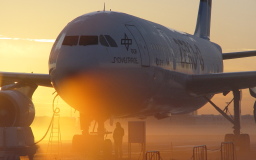
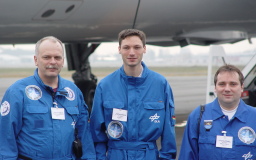
|
PK-3 Plus and PK-4 experiments in micro-gravity
In November, both experiments of MPE dedicated to 'complex plasmas
in micro-gravity' produce new and unique data for the scientists.
In Moscow staff members of MPE and IHED supervise a new experiment
session with PK-3 Plus that is onboard the International
Space Station ISS since December 2005. From the space control center
in Korolev they are in contact with the Russian cosmonaut Yuri
Malenchenko who will operate PK-3 Plus in Earth orbit.
The achieved video data are stored on harddiscs, are brought back
to Earth with the next crew exchange, and then are analysed by
MPE and IHED scientists.
Meanwhile, on Earth another experiment experiences the
conditions of weightlessness. PK-4 takes part in the
11th DLR parabolic flight campaign, funded by the German
Aerospace Research Center. A team of nine MPE and IHED staff
members stay in Bordeaux, France, the home base of the Airbus
A300 'ZERO-G' (pictures on the left), and performs the experiments
on three consecutive days. Each flight day provides 31
parabolic flight manoevers with 20 seconds of weightlessness
each. The experiments are to test the PK-4 apparatus
on one side, on the other to deal with scientific questions.
We investigate the self-organisation effects of a complex
plasma when two particle clouds penetrate each other; the
behavior inside a nozzle is observed; and new means of
manipulation (e.g. thermal) of the particle flows are tested.
Also non-spherical particles ('rods') are used in an experiment
of our colleagues from IHED, Moscow.
PK-4 uses a DC discharge inside a glass tube to generate
the plasma and is intended to investigate complex plasmas mainly
in the fluid state. The project is now at the phase C/D and is
planned to be launched to the ISS in 2009 or 2010 to continue the
success of MPE's plasma facilities PKE-Nefedov and
PK-3 Plus.
|
July 2007
|
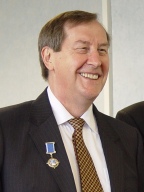

Pictures of the award ceremony:



Courtesy of DLR, M.K.
|
Prof. Gregor Morfill awarded with the Tsiolkovsky Medal
 Prof. Gregor Morfill, Director at MPE and head of the Theory/Complex
Plasma Group (image on the far left), receives the highest award of
the Russian Space Agency, the Tsiolkovsky Medal.
The medal is handed over by a Russian delegation during a
ceremony held at the German Space Agency (DLR) in Bonn-Oberkassel.
Head of the Russian space delegation is Prof. Vladimir Fortov,
former Russian secretary of science, member of the Russian Acadamy of
Science and director of the Institute for High Energy Densities (IHED)
in Moscow. Host and speaker is Dr. Ludwig Baumgarten, member of the
executive board of DLR. Also present at the ceremony are:
Sergey Krikalev (Russian cosmonaut), Thomas Reiter (German astronaut),
Oleg Petrov and Vladimir Molotkow (IHED), Hubertus Thomas (MPE),
Maria Roth (DLR), the Russian consul in Bonn and numerous members of
DLR, MPE and ESA.
Prof. Gregor Morfill, Director at MPE and head of the Theory/Complex
Plasma Group (image on the far left), receives the highest award of
the Russian Space Agency, the Tsiolkovsky Medal.
The medal is handed over by a Russian delegation during a
ceremony held at the German Space Agency (DLR) in Bonn-Oberkassel.
Head of the Russian space delegation is Prof. Vladimir Fortov,
former Russian secretary of science, member of the Russian Acadamy of
Science and director of the Institute for High Energy Densities (IHED)
in Moscow. Host and speaker is Dr. Ludwig Baumgarten, member of the
executive board of DLR. Also present at the ceremony are:
Sergey Krikalev (Russian cosmonaut), Thomas Reiter (German astronaut),
Oleg Petrov and Vladimir Molotkow (IHED), Hubertus Thomas (MPE),
Maria Roth (DLR), the Russian consul in Bonn and numerous members of
DLR, MPE and ESA.
The Tsiolkovsky Medal (image on the left side) is given to ''personnel
of the Russian space industry who made a significant contribution and
active participation in fundamental research in the field of entering
and utilizing space; also to foreign persons with a significant
contribution to space research.'' [1] Former recipients of the medal are:
 Yuri
Gagarin (first man in space), Yuri
Gagarin (first man in space),
 John
Glenn (first American to orbit the Earth), John
Glenn (first American to orbit the Earth),
 Sergey Korolyov (Chief designer of the Soviet space
program), Sergey Korolyov (Chief designer of the Soviet space
program),
 Carl
Sagan (American astronomer (Pioneer,
Voyager and Viking space missions) and award-winning
writer ('Contact', 'Cosmos')), Todd B. Hawley (co-founder of the Carl
Sagan (American astronomer (Pioneer,
Voyager and Viking space missions) and award-winning
writer ('Contact', 'Cosmos')), Todd B. Hawley (co-founder of the
 International Space
University), Peter Diamandis (CEO of the International Space
University), Peter Diamandis (CEO of the
 X Prize Foundation),
and more. X Prize Foundation),
and more.
The medal is named after
 Konstantin E. Tsiolkovsky (1857-1935), the
Russian rocket scientist and space pioneer (image on the right side).
Tsiolkovsky was the first to derive the fundamental theory of space
flight and to propose that liquid fuel and a multi-stage concept
is necessary to leave the Earth (''The Exploration of Cosmic Space
by Means of Reaction Devices'', 1903). Decades later, German Hermann
Oberth (and his student Wernher von Braun) and American Robert Goddard
continued on Tsiolkovsky's work to pave the actual way of humans into
space. A large crater on the far side of the moon is named after
Konstantin Tsiolkovsky. A known quotation of him is:
,,Surely, the Earth is the cradle of mankind, but no one can stay
in cradle forever''. Konstantin E. Tsiolkovsky (1857-1935), the
Russian rocket scientist and space pioneer (image on the right side).
Tsiolkovsky was the first to derive the fundamental theory of space
flight and to propose that liquid fuel and a multi-stage concept
is necessary to leave the Earth (''The Exploration of Cosmic Space
by Means of Reaction Devices'', 1903). Decades later, German Hermann
Oberth (and his student Wernher von Braun) and American Robert Goddard
continued on Tsiolkovsky's work to pave the actual way of humans into
space. A large crater on the far side of the moon is named after
Konstantin Tsiolkovsky. A known quotation of him is:
,,Surely, the Earth is the cradle of mankind, but no one can stay
in cradle forever''.
[1]  www.astronaut.ru (Russian) www.astronaut.ru (Russian)
See also:
 DLR News (German) DLR News (German)
|
June 2007
|
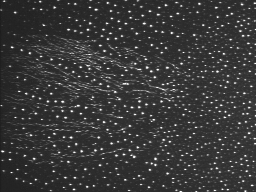
|
Next PK-3 Plus Mission onboard the ISS
End of June MPE's PK-3 Plus Experiment will be conducted onboard
the International Space Station by the cosmonauts of the Expedition
15 crew one more time. This is the 6th mission for PK-3 Plus and the
19th since PKE-Nefedov, the first plasma crystal experiment onboard
the ISS.
The emphasis of this experiment session is on string fluids, where
the microparticles inside the liquid phase of a complex plasma align
in chains which changes the behavior of the liquid drastically.
This is a model for so-called 'electro-rheological liquids' which
increase their viscosity by several orders of magnitude when an
elecrical voltage is applied. Imagine the possibilities! PK-3 Plus
allows to study such a fluid on the kinetic level which means on
the level of individual particles and their dynamics.
Staff members of MPE are in the space control center in Moscow
to supervise the conduction of the experiments in direct contact
with the cosmonauts in orbit.
More about the Plasma Crystal Experiment:
Press information (PDF) (German only)
|
May 2007
|
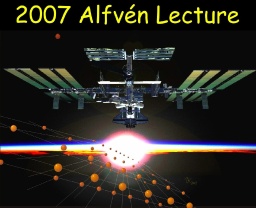
|
Prof. Morfill to give Alfvén Lecture
On May 15th Prof. Gregor Morfill, director at the MPE
and head of the theory/complex plasma group of the institute,
has the honour to give the Alfvén Lecture at the Royal
Technical Institute
( KTH) in
Stockholm.
(See announcement.) KTH) in
Stockholm.
(See announcement.)
The lecture is intended for students, scientists and the interested
public. On the following day there is an informal seminar for
scientists of the Alfvén Lab. The laboratory is made of
three related and co-located units within the School:
Fusion Plasma Physics, Space and Plasma Physics and the Alfvén
Laboratory Centre for Space and Fusion Plasma Physics.
Prof. Morfill joins a series of reputable predecessors:
Astronaut Prof. Franklin Chang-Díaz (2004)
and Prof. Osamu Motojima, Nagoya, Japan, (2002).
 Event kalendar, Event kalendar,
 Announcement of the School of Electrical Engineering, Announcement of the School of Electrical Engineering,
|
April 2007
|
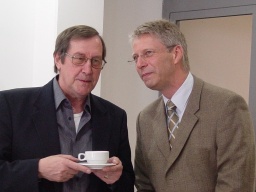
|
Thomas Reiter visits the MPE
The German astronaut Thomas Reiter visits the MPE on April 24th
to exchange experience with the scientists of the institute's
complex plasma group.
Reiter (49) - with 350 days in space (on Mir and ISS) the most
experienced european astronaut - performed the
Plasmakristall-Experiment of the MPE twice during his stay on the
International Space Station.
(See Latest News 2006.)
Thomas Reiter first gave a review of his long-term stay on
the ISS and afterwards visited the institute's labs where he
got a deeper insight in the experiments of the complex plasma
group. Scientists of the group used the visit to get informed
about his stay in space and especially about the performance
of the plasma crystal experiment. Furthermore, Thomas Reiter
gave some valuable hints for the experiments of the MPE planned
in future onboard the International Space Station.
The left image shows Max Planck Director Prof. Gregor Morfill
and Thomas Reiter during a coffee break. More images:
(Description see mouse pointer. Click to enlarge.
All images: © MPE/Michael Kretschmer.)




|
Updated: 2008-01-05
RS
Contact: Michael Kretschmer

|